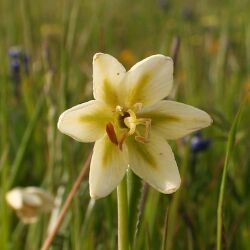Fritillaria liliacea
Topic: Biology
 From HandWiki - Reading time: 2 min
From HandWiki - Reading time: 2 min
| Fragrant fritillary | |
|---|---|

| |
| Scientific classification | |
| Kingdom: | Plantae |
| Clade: | Tracheophytes |
| Clade: | Angiosperms |
| Clade: | Monocots |
| Order: | Liliales |
| Family: | Liliaceae |
| Subfamily: | Lilioideae |
| Tribe: | Lilieae |
| Genus: | Fritillaria |
| Species: | F. liliacea
|
| Binomial name | |
| Fritillaria liliacea Lindl.
| |
| Synonyms[2] | |
| |
Fritillaria liliacea, the fragrant fritillary, is a threatened bulbous herbaceous perennial plant in the lily family Liliaceae. It is native to the region surrounding San Francisco Bay in California , USA.[3][4][5]
Description
The bell-shaped white flowers have greenish stripes and are set on a nodding pedicel of about 37 centimeters in height. The blooms are odorless to faintly fragrant.[6] Fritillia liliacea prefers heavy soils including clays; for example, andesitic and basaltic soils derived from the Sonoma Volcanic soil layers are suitable substrate for this species.[7]
Distribution
The range of this wildflower is over parts of southwestern Northern California, United States, especially Solano and Sonoma counties and at coastal locations south to Monterey County; occurrence is typically in open hilly grasslands at altitudes less than 200 meters in elevation.[4][8]
This California endemic has been a candidate for listing as a U.S. federally endangered species, and some of the remaining fragmented colonies are at risk of local extinction, such that the species is considered locally endangered. Example occurrences are: Edgewood Park in San Mateo County and the Sonoma Mountains foothills in Sonoma County. Examples of highly fragmented or extirpated colonies are in San Francisco due to urban development.[9]
See also
- Sonoma County, California
References
- ↑ "NatureServe Explorer 2.0". https://explorer.natureserve.org/Taxon/ELEMENT_GLOBAL.2.135411.
- ↑ Kew World Checklist of Selected Plant Families
- ↑ Flora of North America, Vol. 26 Page 169, Fragrant fritillary, Fritillaria liliacea Lindley
- ↑ 4.0 4.1 Biota of North America Program, 2014 county distribution map, Fritillaria liliacea Lindley
- ↑ Calflora taxon report, Fritillaria liliacea Lindley, fragrant fritillary
- ↑ Flora of North America: dichotomous key to Fritillia species of North America
- ↑ C.Michael Hogan, John Torrey, Brian McElroy et al., Environmental Impact Report, Southeast Santa Rosa Annexation 2-88, Earth Metrics Inc., Report 7941, California State Clearinghouse, Sacramento, Ca., March 1990
- ↑ Jepson Manual, University of California Press (1993)
- ↑ California Native Plant Society, Rare Plant Program. 2015. Inventory of Rare and Endangered Plants, Fritillaria liliacea
External links
- Photograph of Fritillaria liliacea, University of California @ Davis Botany club
- USDA Plant profile for Fritillaria liliacea
- Fritillariaicones.com" Fritillaria Icones Laurence Hill
- Scottish Rock Garden Club, Bulb Log 29 (2006) — photos of bulbs of this and several other species.
Wikidata ☰ Q5504785 entry
 |
 KSF
KSF

